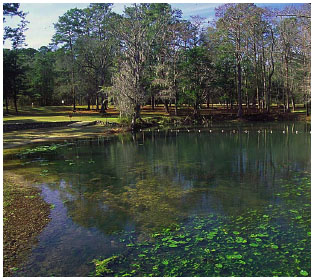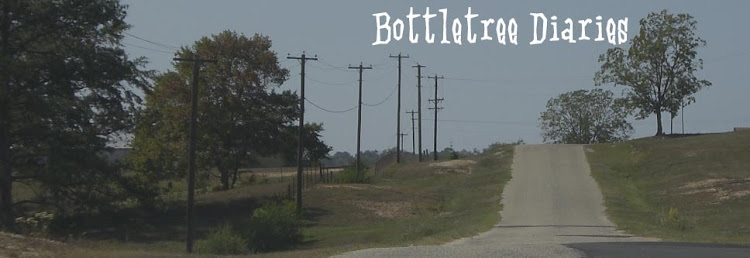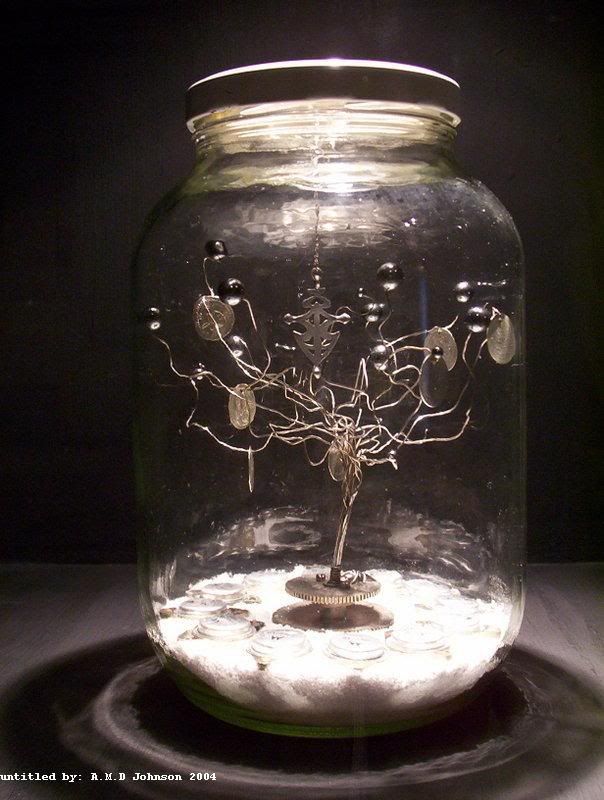Later the Baptist churches in the area held there baptisms there at Blue Hole Spring.

orignal photograph credit :R. Means,
from the Florida Geological Survey

bottletree diaries is a collection of inspirations,observations and practices of someone who walks in both worlds. i am a hereditary rootworker, conjure artist and medicine maker. everything i got been handed down to me. my rants here are solely for my own pleasure and practice, as i am hoping to one day have the honor of being that woman whose house children are afraid to walk by...

There is little doubt that the first contact between Africans and Native Americans did not occur within the contexts of European colonial expansion in the early sixteenth century. Though most texts detailing red/black relations on the Southern frontier begin with Africans among the explorations of Spaniards De Allyon, De Leon, Cordoba, De Soto, and Narvaez, evidently contact was much older. It is an underappreciation of this often untold history of the deep relationship between Africans and Indians that lies at the root of modern misunderstanding of much of American history.
Long before Christopher Columbus, Africans had been using favorable sea currents and small boats to come to the Americas. One of the reasons that Columbus was sent on his return voyage was "a report of the Indians of this Espanola who said that there had come to Espanola from the south and south-east, a black people who have the tops of their spears made of a metal which they call `guanin' (gold)." [6] The North Equatorial Current runs from West Africa to the Caribbean Islands and Southeastern United States; Thor Heyerdahl, in his Kon Tiki and Ra expeditions, proved that even the smallest boats could make this passage. [7]
There is also ample evidence of pre-Columbian contact with Africans in a variety of settings in Mesoamerica. The African characteristics of Olmec sculptures, similarities between African pyramids and reed boats and their counterparts in Mesoamerica, and pictographic/linguistic similarities between Northern African and Muscogean cultures are all evidence of ancient contact. [8] Upon observing the Olmec sculptures in 1869, Dr. Jose Melgar y Serrana reported "As a work of art, it is without exaggeration a magnificent sculpture, but what astonished me was the Ethiopic type represented. I reflect that there had undoubtedly been Negroes in this country." [9]
Dr. Leo Wiener proposed that African traders from Guinea founded a colony near Mexico City from which they exerted a cultural and commercial influence extending north to Canada and south to Peru. He also suggests that Native American ancient cultures, including the Maya, Aztec, and Inca civilizations, were directly or indirectly of African origins. [10] Historians and scientists from Augustus Le Plongeon in the nineteenth century to Barry Fell in the latter half of the twentieth century have asserted African contact with ancient America. [11] Whatever the truth is, it is certain that it was along the coastal rim of the Caribbean and the Gulf of Mexico where the early explorers encountered most African-Indians and tri-racial mixtures. [12]
Taking the African presence in ancient America seriously causes us to reframe our understanding of the relationship between African Americans and Native Americans in the Southeastern United States. What are the implications of this research for understanding Native American attitudes regarding race; moreover, what are the possibilities of African influence in the development of the temple mound culture in the Southeastern United States? Does this historic background explain the ease in which in which Africans learned to speak and translate indigenous languages and the ready assimilation of runaway slaves into Native American communities? It is not the purpose of this paper to fully explore the meaning of this critically underexplored phenomena, but to simply offer up the possibility of a thicker description of southeastern culture. [13]
Modern historians believe that the first Africans to be encountered by Native Americans were those who accompanied the early Spanish explorations of the Southeastern United States. Estavanico, "an Arabian black, native of Acamor," who accompanied Narvaez into Florida distinguished himself by his linguistic ability and "was in constant conversation" with the Indians. [14] In 1540, Hernando de Soto encountered the Cherokee and kidnapped the Lady of Cofitachequi, a prominent Cherokee leader. Escaping from De Soto, she returned home with an African slave belonging to one of De Soto's officers and "they lived together as man and wife." [15] Black slaves also played a critical role in Luis Vazquez de Ayllon's aborted colony in South Carolina; a slave revolt occurred in the colony and many of the African slaves fled to live among the Cherokee. [16]
It is important to understand the purpose of these early Spanish explorations in the Southeast. Ponce de Leon's 1512 patent from the Spanish authorities provided that any Indians that he might discover in the Americas should be divided among the members of his expedition that they should "derive whatever advantage might be secured thereby." [17] De Ayllon's 1523 cedula authorized him to "purchase prisoners of war held as slaves held by the natives, to employ them on his farms and export them as he saw fit, without the payment of any duty whatsoever upon them." [18]
When De Soto landed in Florida with his soldiers in 1539, he brought with him blood-hounds, chains, and iron collars for the acquisition and exportation of Indian slaves. Hundreds of men women and children were captured by de Soto and transported to the coasts for shipment to the Caribbean and to Spain. [19] A Cherokee from Oklahoma remembered his father's tale of the Spanish slave trade, "At an early state the Spanish engaged in the slave trade on this continent and in so doing kidnapped hundreds of thousands of the Indians from the Atlantic and Gulf Coasts to work their mines in the West Indies." [20]
Slavery as a phenomenon was not unknown to the Cherokee Nation or to Native Americans. However, it is distinctively different in both its content and its context as that which was practiced by the European. Rudi Halliburton in Red Over Black, his extensive work on slavery in the Cherokee Nation, concludes that "slavery, as an institution, did not exist among the Cherokees before the arrival or Europeans." [21] Booker T. Washington concurs, "The Indians who first met the white man on his continent do not seem to have held slaves until they first learned to do so from him." [22]
The Cherokee atsi nahtsa'i, or "one who is owned," were individuals captured or obtained through warfare with neighboring peoples and often given to clans who lost members in warfare. [23] To the extent that these individuals existed outside of the clan structure, they were in essence "outsiders" who lived on the periphery of Cherokee society. It was up to the clan-mothers, or "beloved women" of the Nation to decide upon the fate of these individuals. [24] If they accepted these "outsiders" as replacements for those individuals who had lost their lives in battle, these individuals became members of the clan and thus the nation. [25] If the "outsiders" were not accepted into the clan, then they served as the "other" in promoting clan self-understanding and solidarity. [26]
There was not a race-based understanding of "difference" within Native American cultures as that which had come to exist within the European mind over the hundred years following the discovery of the New World. Race as an identifying component in interaction did not exist within the traditional nations of the early Americas; into the nineteenth century the Cherokee were noted for their cultural accommodation. [27] William McLoughlin stressed the importance of clan relationships or larger collective identities (e.g., Ani-Yunwiya, Ani-Tsalagi, Ani-Kituhwagi) within indigenous nations as the critical components in their interactions with outsiders; race was not considered a critical element in perception or hostility. [28] In her pivotal work Slavery and the Evolution of Cherokee Society 1540-1866, Theda Perdue states that the Cherokee regarded Africans they encountered "simply as other human beings," and, "since the concept of race did not exist among Indians and since the Cherokees nearly always encountered Africans in the company of Europeans, one supposes that the Cherokee equated the two and failed to distinguish sharply between the races." [29] Kenneth Wiggins Porter, an African American historian, concurs with this conclusion: [we have] "no evidence that the northern Indian made any distinction between Negro and white on the basis of skin color, at least, not in the early period and when uninfluenced by white settlers." [30]
However, racism and religious intolerance were critical components in the European dispossession and enslavement of Native Americans in the colonial period. Originating in the Aristotelian concept of natural rights, the concept of white supremacy as it developed in the sixteenth century ran along these lines:
Those, therefore, who are as much inferior to others as are the body to the soul and beasts to men, are by nature slaves. He is by nature born slave who...shares in reason to the extent of apprehending it without possessing it. [31]

